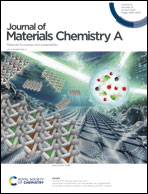High-flux charge transfer layer confers a solid electrolyte interphase with uniform and rich LiF for stable lithium metal batteries†
Abstract
Lithium (Li) metal batteries are considered one of the most promising electrochemical energy storage systems. However, the uncontrollable solid electrolyte interphase (SEI) and Li deposition lead to poor stability and safety concerns, hindering their wide utilization for energy devices. Herein, we propose a high-flux charge transfer layer (HCTL) with efficient mixed electron/ion transport dynamics to achieve a remodeled SEI and highly reversible Li deposition. As a concept, an ultra-thin graphitized reduced graphene oxide/carbon nanotube (GrGO/CNT) film has been designed and fabricated as an HCTL to protect the Li anode. The fabricated GrGO/CNT film exhibits excellent electronic conductivity and ionic diffusivity. As a result, the Li/HCTL electrode based on GrGO/CNT exhibits a prolonged cycling lifespan with a high current density and high areal capacity (2.5 mA cm−2, 2.5 mA h cm−2 with 2000 cycles). These excellent properties have been proved to benefit the uniform, LiF-rich and strengthened SEI induced by this HCTL. As a result of the synergistic effects of the fast electron/ion transport dynamics and the reformative SEI layer, the assembled Li/HCTL‖LiCoO2 full battery delivers satisfactory cycling stability and high-rate performance. This study presents a fresh strategy to fabricate high-performance Li anodes for stable Li metal batteries.



 Please wait while we load your content...
Please wait while we load your content...